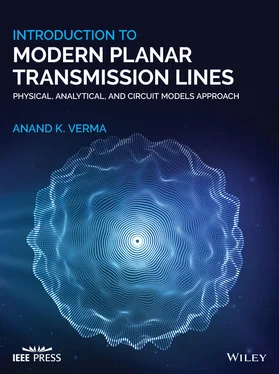5.5 EM‐Waves in Metamaterials Medium
The electromagnetic properties of metamaterials, propagation of EM – waves in the metamaterials media, and circuit models of metamaterials are presented in this section. Some applications of the metamaterials are also discussed. The realization of engineered metamaterials and their further modeling are discussed in chapter 21.
5.5.1 General Introduction of Metamaterials and Their Classifications
The materials existing in nature, ignoring losses, are characterized electromagnetically by the relative permittivity and relative permeability. Normally, these are positive quantities. Such a medium is called the double‐positive (DPS) medium . It has a positive real refractive index n. It is placed in the first quadrant of the (μ r, ε r)‐plane as shown in Fig (5.7). The conductivity or resistivity is added to a medium to account for the losses. Some noble metals, such as silver and gold, have negative permittivity in the visible frequency bands. Drude model, based on the plasma model of metal, is used to model such behavior. It is discussed in chapter 6, section (6.5.2). An identical phenomenon exists in the ionospheres. Below the so‐called plasma frequency mentioned briefly in section ( 3.3.1) of chapter 3, the permittivity of a plasma medium becomes negative. In this case, the medium does not support wave propagation. The waves become oscillatory decaying evanescent mode. The permeability of the plasma medium remains a positive quantity. Under the evanescent mode condition, the plasma medium below the cut‐off frequency is called the epsilon‐negative (ENG) medium . It is shown in the second quadrant in Fig (5.7). Thus, below the plasma frequency, the medium reflects the wave incident on it from the DPS medium; while inside the ENG medium only decaying evanescent mode exists. However, above the plasma frequency, the ENG plasma medium becomes a normal DPS medium. Likewise, a gyrotropic medium, such as a ferrite medium, has negative permeability over a lower microwave frequency range. However, its permittivity is a positive quantity. Such a medium is called the mu‐negative (MNG) medium . It is shown in the fourth quadrant of Fig (5.7). Both the ENG and MNG media have imaginary refractive index n and support only decaying evanescent mode, as shown in Fig (5.7). As a single negative medium, both the ENG and MNG belong to the group of the single negative, i.e. ( SNG ) medium . Both the ENG and MNG are described by the following forms of the Drude model:
(5.5.1) 
where ω epand ω mpare the electric plasma and the magnetic plasma frequency respectively. The magnetic plasma is conceptual as no magnetic charge is available in nature.
The natural dielectric and magneto‐dielectric media support the slow‐wave propagation as for these media ε r> 1, μ r> 1. However, it is possible to engineer a DPS metamaterial for 0 < ε r< 1, μ r≥ 1 and 0 < μ r< 1, ε r≥ 1. The first medium is called epsilon near zero (ENZ) medium, while the second one is called mu near‐zero (MNZ) medium. They belong to the group called near‐zero (NZ) medium. These media support the fast‐wave . The DNG medium also supports the ENZ and MNZ cases. The NZ medium is shown as a dark circle at the origin in Fig (5.7). These media are obtained just above the plasma frequency. The refractive index of the ENZ and MNZ is numerically less than unity, supporting the fast‐wave. Even a zero refractive index could be obtained. It is known as the “ nihility ” [B.6].

Figure 5.7 Electrical grouping of the materials media in the (μ r, ε r)‐plane.
Following the above‐discussed nomenclature scheme of a material medium, it is natural to envisage an artificial medium with both the permittivity and permeability as negative quantities. Such an engineered medium could be called a double negative medium (DNG) medium . It is shown in the third quadrant of Fig (5.7). It has a negative refractive index (−n). The DPS medium supports the wave propagation such that both the phase velocity v pand group velocity v gare in the same direction, whereas the DNG medium supports wave propagation with phase velocity v pand group velocity v gin opposite directions. Such EM‐wave is known as the backward wave . However, no DNG material is known to exist in nature. The DNG material medium has been synthesized over certain frequency bands, from the microwave to optical frequency ranges.
The DNG materials are commonly known as metamaterials . However, artificially engineered ENG, MNG, ENZ, and MNZ media also belong to the metamaterials. Even the DPS could be engineered, and called a metamaterial, to realize the controlled values of permittivity and permeability to meet the specific design requirement. One such requirement is to develop the microwave absorbers discussed in sub section (5.5.8). Several dedicated books are available on the topics of the metamaterials [B.6–B.10].
Depending on their characteristics, several other names have also been proposed for the metamaterials [B.7, B.10]. Veselago proposed the concept and electrodynamics of the metamaterials [J.3]. The metamaterials have been synthesized by embedding either the resonating type inclusions or the C‐L type artificial transmission line inclusions in a host medium. The metamaterials could be either resonant metamaterials or nonresonant metamaterials , so the metamaterials are structured composite materials. Starting with J.C. Bose, such composite materials have a long history [J.4–J.6]. The concept of composite materials and their modeling is discussed in section (6.3) of chapter 6. The C‐L line supports the backward wave propagation. It is discussed in section (3.4)of chapter 3. A metamaterial, i.e. the DNG medium, is also called the backward wave (BW) medium , or BW material [J.7]. The normal forward wave supporting DPS medium could be called forward wave (FW) medium , or FW material.
The physical dimensions of the resonating inclusions, or the C‐L line inclusions, are much smaller than the operating wavelengths. The metamaterials could be treated as the homogenized medium described by the parameters permittivity and permeability. The inclusions are arranged in the host medium either periodically, or nonperiodically. The periodically arranged inclusions, with a period λ g/2, form another group of metamaterials known as the electronic bandgap (EBG) materials. It is discussed in chapters 19and 20. Even the ENG and MNG materials have been artificially developed using such inclusions.
The (μ r, ε r)‐plane of Fig (5.7)summarizes the above‐discussed four‐groups of material media with their basic electrical characteristics. The circuit models and further wave characteristics of these media are shown in Fig (5.10). The synthesis, modeling, and some illustrative applications of the metamaterials are discussed in chapter 21. This section only presents some basic electrodynamics properties of the DNG medium.
5.5.2 EM‐Waves in DNG Medium
This section considers the EM‐wave propagation in the lossless DNG medium, the concept of the negative refractive index, the basic circuit model of a DNG medium, and the lossy DNG medium.
Читать дальше














